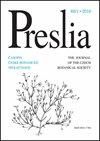西北潘诺尼亚森林草原底物相关生物地理格局
IF 2.9
2区 生物学
Q1 PLANT SCIENCES
引用次数: 3
摘要
喀尔巴阡盆地西北部是一个重要的生物地理学十字路口。这个过渡区域介于潘诺尼亚生物地理区域的森林-草原生物群落和温带森林生物群落之间,在森林中,特别是在崎岖的景观中,有零散的天然草原斑块。独特的地理位置反映在植物组合上,植物组合由不同来源的物种组成,主要是中欧、大陆、地中海和亚地中海。我们在该地区的不同基质上取样了保存完好的森林草原植被。在每个地点,我们对三种生境的植被进行采样:草原、森林和过渡带。然后,我们试图理清地理位置、气候和基质对森林草原景观物种组成的影响,以及具有特定分布类型的物种百分比。发现基质是决定物种分选的主要因素。基材也在很大程度上决定了具有特定分布类型的物种的百分比。大陆种主要分布在黄土上,地中海种主要分布在安山岩上。亚地中海种在白云岩上最常见,在黄土上罕见。这些物种的分布可以用其原生地核心的环境条件来解释。本研究显示的西北潘诺尼亚森林草原物种分布格局的复杂性应在讨论该地区的环境历史和保护规划时加以考虑。本文章由计算机程序翻译,如有差异,请以英文原文为准。
Substrate associated biogeographical patterns in the north-western Pannonian forest-steppe
The north-western part of the Carpathian Basin is an important biogeographical crossroad. This transitional area between the forest-steppe biome of the Pannonian biogeographical region and the temperate forest biome hosts scattered patches of natural steppe embedded in forests, especially in rugged landscapes. The unique geographical position is reflected in the plant assemblages, which are composed of species of different origins, mainly central-European, continental, Mediterranean and sub-Mediterranean. We sampled sites with well-preserved forest-steppe vegetation on different substrates across this region. At each site, we sampled the vegetation in three habitats: steppe, forest and ecotone. We then attempted to disentangle the influence of geographical location, climate and substrate on the species composition of forest-steppe landscapes and the percentage of the species with a particular type of distribution. We found that substrate is the main factor determining species sorting. Substrate is also largely responsible for the percentage of species with particular types of distribution. While continental species are most frequent on loess, Mediterranean species are mainly found on andesite. Sub-Mediterranean species are most frequent on dolomite and rare on loess. The distributions of these species can be explained by the environmental conditions in the core of their native ranges. The complexity of the distribution patterns of species in the north-western Pannonian forest-steppe shown in this study should be considered in the discussion of the environmental history of the region and conservation planning.
求助全文
通过发布文献求助,成功后即可免费获取论文全文。
去求助
来源期刊

Preslia
生物-植物科学
CiteScore
5.20
自引率
29.40%
发文量
8
审稿时长
>12 weeks
期刊介绍:
Preslia is a peer-reviewed scientific journal publishing original research papers on plant systematics, morphology, phytogeography, ecology and vegetation science, with a geographical focus on central Europe. The journal was founded in 1914 and named in honour of brothers Jan Svatopluk Presl (1791–1849) and Karel Bořivoj Presl (1794–1852), outstanding Bohemian botanists. It is published quarterly by the Czech Botanical Society.
 求助内容:
求助内容: 应助结果提醒方式:
应助结果提醒方式:


